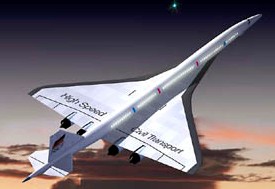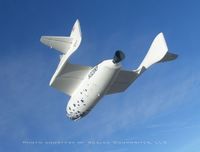Like the automobile, the airplane is an icon of the 20th century. It began with the Wright Brothers and their successful launch of the ” Flyer” in 1903, and by the end of the century saw space shuttles, supersonic transports, and scramjets.

The Flyer looked more like a box kite than an airplane. Today’s aircraft bear no resemblance to it. New materials, engine technologies, computer controls and scale have turned the airframe at Kitty Hawk into behemoths like the one seen in the image below.

The Wright Flyer on that first flight could attain a speed of 16 kilometers (10 miles) per hour and travelled 852 feet. Today’s commercial aircraft fly at speeds of 900 kilometers (over 550 miles) per hour and travel from New York to Singapore without refueling. Experimental aircraft such as the rocket-powered X-15 in 1967 reached a speed of close to 7,000+ kilometers (4,500 miles) per hour. How far we came in the 20th century. Where do we go from here?
The Evolution of Commercial Flight
There are more than 49,000 airports in the world today. Today it takes longer to fly between destinations in North America than it did in 1960. Navigation systems are antiquated based on radio beacon technology and skies are more congested than ever with airplane traffic flow experiencing bottlenecks near major airport hubs.
The future of commercial flight, particularly passenger-based aircraft, looks at accessibility, energy conservation, speed, safety and comfort. Commercial airlines want to optimize flight volume and landing locations. This means a wider variety of aircraft capable of landing almost anywhere and smart traffic management systems.
The National Air and Space Administration (NASA) has been a catalyst for aircraft concepts in the commercial sector. In this blog I share with you some of the concepts that NASA and its commercial partners are proposing for the first half of the 21st century.
Several manufacturers have proposed lighter and more aerodynamic aircraft with the variable passenger capacity to meet a wider range of locations and demand. One of these, GE Aviation has developed a prototype 20-passenger aircraft designed to reduce fuel consumption, minimize engine noise, provide comfort equal to modern passenger jets, and the capability to land in smaller airports previously inaccessible to commercial passenger aircraft. The concept aircraft uses fuel cells to power its electrical systems, and low-noise propellers with advanced turboprop engine technology capable of very short takeoffs and landings and quick vertical climbs.
Our largest commercial aircraft today, the A380 seen in the picture above, can handle 600 or more passengers. But NASA and Airbus are both proposing new designs that incorporate a Blended Wing Body or BWB. These aircraft are capable of handling a variety of passenger loads from 600 to over 1,000 passengers. A prototype, the NASA X-48B, developed at Boeing Phantom Works, a R&D laboratory, has flown more than 50 times to prove the capability of BWB design. The full-size version of the Boeing BWB, seen below, would feature a blended wing, engine and body design with passengers seated on two decks.

Going Supersonic Again
The demise of the Concorde and Tupolev TU-144 supersonic commercial aircraft has not ended the interest in developing faster than sound capability. NASA and industry partners have designed concepts for the next-generation supersonic transport (SST) planned for deployment by 2030. A passenger jet that would fly 300 passengers at more than 2,400 kilometers (1,500 miles) per hour it would be capable of crossing oceans in half the time of current passenger jets. This next generation SST would feature a propulsion system that used green fuels and noise abatement technology to reduce sonic booms making it possible to fly over the continental land mass, unlike Concorde. Instead of cockpit windows, the pilots would use sensor displays with video imaging and computer-generated graphics to exceed human vision and eliminate the need to drop the nose of the aircraft as was required in the Concorde and Tupolev.

The SST shown above uses engine materials capable of withstanding 1,650 degrees Celsius (3,000 Fahrenheit) over the duration of a flight. Boeing and Lockheed Martin have proposed designs that incorporate engine design and placement that eliminates sonic booms and reduce greenhouse gas emissions. These concepts were presented to NASA in 2010 with plans for commercialization by the mid 2030s.
Another next-generation supersonic jet closer to flying is named after a fleet-of-foot horse in Greek mythology, Aerion. The first SST business jet, Aerion would carry a dozen passengers at speeds of up to 1,600 kilometers (1,000 miles) per hour for 6,400 kilometers (4,000 miles). Aerion has undergone aerodynamic testing at NASA both in wind tunnels and airborne. It features supersonic natural laminar flow (SNLF), a technology that decreases surface friction by 90% compared to conventional airframe skin designs. The first Aerion is expected to fly as early as 2014.
Hypersonic Aircraft
Hypersonic flight reaches speeds in excess of 6,000 kilometers (3,700 miles) per hour, or Mach 5 and above. Rockets up until now have been the sole means of traveling at these kinds of speeds, but military research into scramjets is making it possible to bring this technology to commercial application. The X-51A Waverider is one of a number of unmanned test vehicles being used to test hypersonic flight. The X-51A uses a rocket booster to launch before deploying the air-breathing scramjet. The Falcon HTV-2 is another test vehicle that is deployed initially by rocket and capable of speeds approaching 20,000 kilometers (12,000 miles) per hour within the atmosphere. An aircraft flying at that speed would travel from London, England, to Sydney, Australia in less than 50 minutes. Scramjet technology can take commercial aviation to the edge of space and when combined with rockets spawn space plane technology that takes off and lands on runways similar to those used by commercial jets today.
Although much of the research on scramjet technology is coming from defence budgets, one company, Airbus, in 2011, provided a glimpse of the near future with its hypersonic concept, ZEHST, standing for Zero Emission Hypersonic Transport. Airbus is proposing a 100-passenger aircraft powered by jet, scramjet and possibly rocket engines capable of flying at 5,000 kilometers (3,100 miles) per hour at elevations of approximately 32 kilometers (20 miles) turning today’s 8-hour flight from New York to London into a one hour hop. Airbus estimates that airplanes similar to ZEHST will be deployed by 2050.

ZEHST would use biofuel-powered jet engines during low atmosphere ascent and landing before switching to a pollution-free hydrogen rocket-based scramjets (RBCC) as it operates in the upper atmosphere close to the edge of space.
Space Aircraft
With the launch of the NASA Shuttle in the 1970s, the airplane form factor was introduced into space travel. Prior to the Shuttle all launches were traditional rocket designs, cylinders with vanes and rocket engines. The Shuttle’s original design included jet engines for use on atmospheric descent and landing but weight considerations and cost soon removed jet engines from the design turning it into a very sophisticated and heavy glider. Hypersonic aircraft may give us the opportunity to recapture the idea of a space plane.
Commercial developers have also been experimenting with space planes. The 1994 announcement of the $10 million Ansari X Prize led to the development of Burt Rutan’s SpaceShipOne. The prize initiated a commercial space race focused on sending a piloted space craft to a height of 100 kilometers (62 miles) and returning it to Earth for relaunch and return within a week. SpaceShipOne accomplished the feat in October of 2004. Truly a space plane, the craft was mated to a parent twin turbojet aircraft and then launched once airborne. SpaceShipOne used nitrous oxide and solid rubber as its fuel source. It had foldable wings designed to provide high levels of drag upon reentering the atmosphere.

SpaceShipOne’s successor is SpaceShipTwo, the first commercial space plane designed to take a crew of 2 along with 6 passengers into suborbital flight. Of course, suborbital flight is not the ultimate goal of space planes. The ability to transition from aircraft to spacecraft and back will lead to many designs, one of which is pictured below. In this Boeing concept a mated-pair of air and space craft separate. While one remains in the upper atmosphere or returns to the surface, the other proceeds into orbit. These space technologies will employ a combination of high-speed turbine jet engines, RBCC and turbine scramjets (TBCC), reusable high-performance rocket engines with lightweight fuel tanks and airframe structures, and high-temperature materials and thermal protection systems for re-entry.

Reaction Engines, a British company, has been developing SABRE, an engine that operates in dual mode as an air-breathing turbojet and rocket-propelled system once in the upper atmosphere. When deployed in a space plane such as the Skylon, pictured below, this technology would create a seamless journey from runway to space and back.

















[…] gulping oxygen and turning it into jet fuel, the High-tech “scramjet” has been described as the “future aircraft” of the 21st century. But here’s the thing: It’s […]
[…] gulping oxygen and branch it into jet fuel, a High-tech “scramjet” has been described as a “future aircraft” of a 21st century. But here’s a thing: It’s a 21st […]